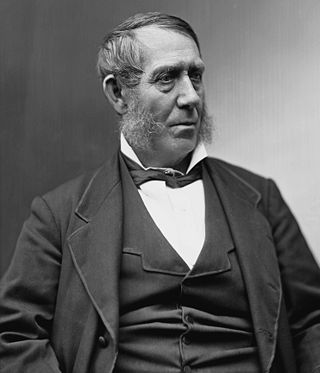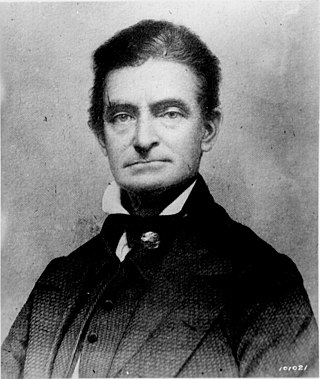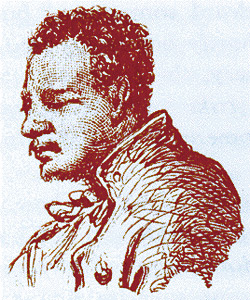
Harpers Ferry is a historic town in Jefferson County, West Virginia, in the lower Shenandoah Valley. The town's population was 269 at the 2020 United States census. Situated at the confluence of the Potomac and Shenandoah rivers, where Maryland, Virginia, and West Virginia meet, it is the easternmost town in West Virginia.

John Brown was an American evangelist who was a prominent leader in the American abolitionist movement in the decades preceding the Civil War. First reaching national prominence in the 1850s for his radical abolitionism and fighting in Bleeding Kansas, Brown was captured, tried, and executed by the Commonwealth of Virginia for a raid and incitement of a slave rebellion at Harpers Ferry in 1859.

Samuel Jordan Kirkwood was an American politician who twice served as governor of Iowa, twice as a U.S. Senator from Iowa, and as the U.S. Secretary of the Interior.

Dangerfield F. Newby, was the oldest of John Brown's raiders, and one of the five black raiders. He died during Brown's raid on the federal armory in Harpers Ferry, Virginia.

John Brown's Fort was initially built in 1848 for use as a guard and fire engine house by the federal Harpers Ferry Armory, in Harpers Ferry, Virginia. An 1848 military report described the building as "An engine and guard-house 35 1/2 x 24 feet, one story brick, covered with slate, and having copper gutters and down spouts…"

Virginia v. John Brown was a criminal trial held in Charles Town, Virginia, in October 1859. The abolitionist John Brown was quickly prosecuted for treason against the Commonwealth of Virginia, murder, and inciting a slave insurrection, all part of his raid on the United States federal arsenal at Harpers Ferry, Virginia. He was found guilty of all charges, sentenced to death, and was executed by hanging on December 2. He was the first person executed for treason in the United States.
It was in many respects a most remarkable trial. Capital cases have been exceedingly few in the history of our country where trial and conviction have followed so quickly upon the commission of the offense. Within a fortnight from the time when Brown had struck what he believed to be a righteous blow against what he felt to be the greatest sin of the age he was a condemned felon, with only thirty days between his life and the hangman's noose.

John Anthony Copeland Jr. was born free in Raleigh, North Carolina, one of the eight children born to John Copeland Sr. and his wife Delilah Evans, free mulattos, who married in Raleigh in 1831. Delilah was born free, while John was manumitted in the will of his master. In 1843 the family moved north, to the abolitionist center of Oberlin, Ohio, where he later attended Oberlin College's preparatory division. He was a highly visible leader in the successful Oberlin-Wellington Rescue of 1858, for which he was indicted but not tried. Copeland joined John Brown's raid on Harpers Ferry; other than Brown himself, he was the only member of John Brown's raiders that was at all well known. He was captured, and a marshal from Ohio came to Charles Town to serve him with the indictment. He was indicted a second time, for murder and conspiracy to incite slaves to rebellion. He was found guilty and was hanged on December 16, 1859. There were 1,600 spectators. His family tried but failed to recover his body, which was taken by medical students for dissection, and the bones discarded.

Shields Green, who also referred to himself as "Emperor", was, according to Frederick Douglass, an escaped slave from Charleston, South Carolina, and a leader in John Brown's raid on Harpers Ferry, in October 1859. He had lived for almost two years in the house of Douglass, in Rochester, New York, and Douglass introduced him there to Brown.

The John Brown Farm State Historic Site includes the home and final resting place of abolitionist John Brown (1800–1859). It is located on John Brown Road in the town of North Elba, 3 miles (5 km) southeast of Lake Placid, New York, where John Brown moved in 1849 to teach farming to African Americans. It has been called the highest farm in the state, "the highest arable spot of land in the State, if, indeed, soil so hard and sterile can be called arable."

Springdale is a small unincorporated community in Cedar County, Iowa, United States. Historically, the town was predominantly settled by Quakers, and was one of Iowa's most important stations on the Underground Railroad.

The Kennedy Farm is a National Historic Landmark property on Chestnut Grove Road in rural southern Washington County, Maryland. It is notable as the place where the radical abolitionist John Brown planned and began his raid on Harpers Ferry, Virginia, in 1859. Also known as the John Brown Raid Headquarters and Kennedy Farmhouse, the log, stone, and brick building has been restored to its appearance at the time of the raid. The farm is now owned by a preservation nonprofit.

John Brown's raid on Harpers Ferry was an effort by abolitionist John Brown, from October 16 to 18, 1859, to initiate a slave revolt in Southern states by taking over the United States arsenal at Harpers Ferry, Virginia. It has been called the dress rehearsal for, or tragic prelude to, the American Civil War.

John Brown Jr. was the eldest son of the abolitionist John Brown. His mother was Brown's first wife, Dianthe Lusk Brown, who died when John Jr. was 11. He was born in Hudson, Ohio. In 1841 he tried teaching in a country school, but left it after one year, finding it frustrating and the children "snotty". In spring 1842 he enrolled at the Grand River Institute in Austinburg, Ohio. In July 1847 he married Wealthy Hotchkiss (1829–1911), who had also studied at the Grand River Institute. The couple settled in Springfield, Massachusetts, and had two children.

Owen Brown was the third son of abolitionist John Brown. He participated more in his father's anti-slavery activities than did any of his siblings. He was the only son to participate both in the Bleeding Kansas activities — specifically the Pottawatomie massacre, during which he killed a man — and his father's raid on Harpers Ferry. He was the only son of Brown present in Tabor, Iowa, when Brown's recruits were trained and drilled. He was also the son who joined his father in Chatham, Ontario, Canada, when the raid was planned; he was chosen as treasurer of the organization of which his father was made president.

The Heyward Shepherd monument is a monument in Harpers Ferry, West Virginia, dedicated in 1931. It commemorates Heyward Shepherd, a free black man who was the first person killed during John Brown's raid on Harpers Ferry.
On Sunday night, October 16, 1859, the abolitionist John Brown led a band of 22 in a raid on the federal arsenal at Harpers Ferry, Virginia.

Watson Brown was a son of the abolitionist John Brown and his second wife Mary Day Brown, born in Franklin Mills, Ohio. He was married to Isabell "Belle" Thompson Brown, and they had a son Frederick W., who died of diphtheria at age 4, and is buried at what is now the John Brown Farm State Historic Site in North Elba, New York.
The Winchester Medical College (WMC) building, currently located at 302 W. Boscawen Street, Winchester, Virginia, along with all its records, equipment, museum, and library, was burned on May 16, 1862, by Union troops occupying the city. This was "retaliation for the dissection of cadavers from John Brown's Raid". More specifically, it was in retaliation for the desecration they discovered of one of those cadavers, the body of one of John Brown's sons, identified years later as Watson. The body of John Brown's son, fighting against slavery in the raid on Harpers Ferry, had been dishonored: made into an anatomical specimen in the College's museum, with the label "Thus always with Abolitionists". In addition, students at the school collected and then dissected the bodies of three other members of Brown's troop and a black boy was apparently tortured and killed there for favoring the Union.

The abolitionist John Brown was executed on Friday, December 2, 1859, for murder, treason against the Commonwealth of Virginia, and for having led an unsuccessful and bloody attempt to start a slave insurrection. He was tried and hanged in Charles Town, Virginia. He was the first person executed for treason in the history of the country.


















